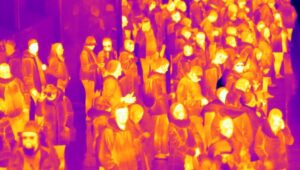
For a long time, thermal solutions such as thermal cameras and imagers have been used for surveillance. However they also have temperature-based screening and access control applications, which have gained more importance nowadays with the spread of the novel coronavirus, COVID-19.
Needless to say, the human body emits infrared radiation that, while not visible to the naked eye, can be detected by various IR and thermal solutions. Applications vary. For those of us working in security, these solutions, for example thermal imaging, are used to detect intruders or other objects during nighttime or inclement conditions. When you need to monitor the perimeters of large military bases or prison compounds in the middle of the night, thermal imaging can be quite helpful.
Yet thermal solutions have other applications as well, especially in the area of access control and screening at airports, enterprises and other end user entities to detect elevated body temperatures and ultimately help prevent communicable diseases.
These solutions have proven helpful during past outbreaks of diseases such as SARS, the bird flu, the swine flu and E-bola. Now, thermal solutions have come to light again in the wake of COVID-19, which as of Feb. 27 has infected 82,166 worldwide and killed 2,804. Countries have imposed restrictions on travelers from the more affected regions, and thermal solutions are needed more than ever at end user organizations to detect the temperatures of individuals.
That said, below are thermal solutions that are commonly used for access control and screening purposes.
Infrared temperature sensors
Infrared temperature sensors can be divided into two categories, contact and non-contact. For offices or other end user entities that screen people during rush hours when they come to work, contact is not feasible. In this regard, end users may find useful non-contact IR temperature sensors, which typically employ thermopile sensors designed to measure temperature from a distance.
“Non-contact infrared thermometers (NCITs) can provide temperature readings within seconds. Most NCITs measure temperature over the central forehead area, but temperature over other body surfaces may also be measured,” said the UK National Institute for Health Research. “Since the use of NCITs does not involve any body surface contact, the risk of cross-infection is negligible and neither disinfection nor disposable probe covers are needed.”
Thermal cameras
IR thermometers take people’s temperatures one at a time. While that may be sufficient for offices, companies and other smaller-scale entities, doing so for large numbers of people is impractical. For screening of crowds at large-scale end user entities, for example airports, operators are looking for a faster, contactless and reliable method for detecting elevated temperatures.
That said, airports and similar entities turn to thermal cameras, which produce thermal images or heat pictures that display temperature differences, helping operators to detect those with high or abnormal temperatures. Since thermal cameras produce images in real time, the total evaluation process takes less than a second, making these cameras an effective and ideal tool for rapid screening of people.
It’s interesting to note that while in the screening process, administrators usually set a threshold (for example 37.5 degrees Celsius) above which the person may be singled out for further examination, such procedure may be flawed as a person exiting a cool environment, for example inside a plane, may have a lower body temperature yet still have a fever. That’s why technologies such as automatic temperature compensator can be helpful. It compares a person’s temperature with those of others; once a person is detected to have an abnormally higher temperature from the rest, he/she will be singled out.
What to know when selecting a thermal camera

Over the years, thermal cameras have become popular in several verticals. From border surveillance and defense forces to industrial manufacturing and even health care, customers now use thermal cameras in some way or the other. With the recent issue of Corona Virus, thermal cameras have become an integral unit in airports and commercial spaces too.
But unlike regular cameras, not many customers are aware of certain key factors that they need to consider when selecting a thermal camera. This is mainly because thermal cameras are still a relatively new concept for many security customers. And since they capture something that the naked eye cannot see, at least some of them feel that the technology is too complicated to understand.
So here’s a brief look at some of the significant factors to consider when buying a thermal camera.
- Temperature range
Thermal cameras have a range within which they can detect temperature. You should purchase a camera that would meet your temperature needs. For example, the cameras used at airports now are for human temperature monitoring. Hence their range just needs to include the highest and lowest points that a human body can sustain. However, in the industrial segment, the temperature may be higher.
- Accuracy
Thermal imaging cameras are often not just to detect higher or lower temperatures but also the calculate the differences. This means that the readings should be as accurate as possible. Most top-end cameras provide a +/- 2 percent accuracy. The distance at which the camera can maintain this accuracy is also critical.
In border surveillance, a good thermal camera can accurately detect the people or object more than 150 meters away. The camera can also detect people with high temperature fast, with an error rate of just +/-0.3 degree Celsius.
- Resolution
Thermal cameras tend to have lower resolution compared to their regular counterparts, and hence this should be an essential consideration before purchase. The size of the area you need to capture and the nature of the target will decide the resolution you need. If you need to capture small objects in detail, high-resolution cameras will be necessary.
- Durability
Customers who use thermal cameras are often those who manage outdoor or rugged environments. Border security, for instance, requires cameras that can work in relatively more adverse conditions than those in urban areas. Similarly, cameras in the oil and gas segment would need to withstand the harsh conditions at a refinery, rig, etc.
Hence, the durability of the camera is an essential factor to consider.
- Cybersecurity
Developments in IP has enabled thermal cameras to connect with other network devices and be part of the IT infrastructure. However, this naturally gives rise to cybersecurity concerns. This issue received much attention during the US-China trade war, which saw the US banning several Chinese companies citing cybersecurity concerns.
The US government also used the National Defense Authorization Act (NDAA) to mandate federal agencies and their grant or loan recipients to use only devices that are compliant with the act.
High-sensitivity locations like national borders, manufacturing segments, and health care often, where information security would be a major consideration need thermal cameras.
- Image comparison
In certain situations, you might need to use a camera that can provide both thermal as well as visible cameras to compare the conditions better. If this is necessary, you may consider solutions that have both technologies infused into a single device. This is easier than having two separate devices for thermal and regular video recording.
Adapted from a&s Magazine



































































